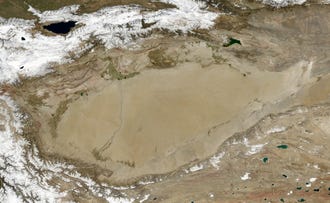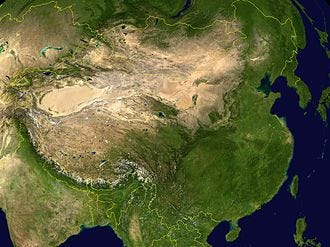Modern China : The Uyghurs

The Uyghurs are a Turkic minority ethnic group originating from and culturally affiliated with the general region of Central and East Asia.

The Uyghurs are recognized as native to the Xinjiang Uyghur Autonomous Region of the China. The historical name for this region is Altishahr, an Uyghur name referring to "the six cities" of the Tarim. They are considered to be one of China's 55 officially recognized ethnic minorities. The Uyghurs are recognized by China only as a regional minority within a multicultural nation and China rejects the idea of them being an indigenous group.

Map showing the location of the Xinjiang Uyghur Autonomous Region
The Uyghurs have traditionally inhabited a series of oases scattered across the Taklamakan Desert within the Tarim Basin, a territory that has historically been controlled by many civilizations including China, the Mongols, the Tibetans, and various Turkic polities. The Uyghurs gradually started to become Islamized in the 10th century and most Uyghurs identified as Muslims by the 16th century. Islam has since played an important role in Uyghur culture and identity.
Since 2016, it is estimated that over a million Uyghurs have been detained in Xinjiang re-education camps. The camps were established under Xi Jinping’s administration. According to Chinese government operating procedures, obtained by the International Consortium of Investigative Journalists (ICIJ), the main feature of the camps is to ensure adherence to Chinese Communist Party ideology. Inmates are continuously held captive in the camps for a minimum of 12 months depending on their performance in Chinese ideology tests. Communication between inmates and their family members is limited to one phone call per week. In 2017, Human Rights Watch released a report saying "The Chinese government agents should immediately free people held in unlawful 'political education' centers in Xinjiang, and shut them down."United Nations and many media reports said as many as one million people are held in such "re-education camps" in this region. As of November 2019, 1 in 10 Uyghurs are being detained in re-education camps.
You can a BBC video on their current situation here :
Where they live : The Taklamakan Desert & Tarim Basin
The Taklamakan Desert is a desert in Southwest Xinjiang. he name may be a Uyghur borrowing of the Persian tark, "to leave alone/out/behind, relinquish, abandon" + makan, "place". Some sources claimed it means "Place of No Return", more commonly interpreted as "once you get in, you'll never get out" or similar. Another plausible explanation suggests it is derived from Turki taqlar makan, describing "the place of ruins".

Taklamakan by NASA World Wind
The Taklamakan Desert has an area of 337,000 km2 (130,000 sq mi) making it slightly smaller than Germany and includes the Tarim Basin, which is 1,000 kilometres (620 mi) long and 400 kilometres (250 mi) wide. It is crossed at its northern and at its southern edge by two branches of the Silk Road as travellers sought to avoid the arid wasteland. It is the world's second largest shifting sand desert with about 85% made up of shifting sand dunes ranking 16th in size in a ranking of the world's largest deserts.

Tarim Basin is the oval desert in the West
China has constructed two cross-desert highways. The Tarim Desert Highway links the cities of Hotan (on the southern edge) and Luntai (on the northern edge) and the Bayingol to Ruoqiang road crosses the desert to the east.
In recent years, the desert has expanded in some areas, its sands enveloping farms and villages as a result of desertification. Because it lies in the rain shadow of the Himalayas, Taklamakan is a paradigmatic cold desert climate.
"When I woke up one morning, I found I couldn't open the door because of the weight of sand that had accumulated overnight. My crops were buried too, so I had no choice but to move" -Memet Simay, Qira County resident
Xinjiang consists of two main geographically, historically, and ethnically distinct regions with different historical names, Dzungaria and the Tarim Basin (Altishahr), before Qing China unified them into one political entity called Xinjiang province in 1884. At the time of the Qing conquest in 1759, Dzungaria was inhabited by steppe dwelling, nomadic Tibetan Buddhist Dzungar people, while the Tarim Basin (Altishahr) was inhabited by sedentary, oasis dwelling, Turkic speaking Muslim farmers, now known as the Uyghur people. They were governed separately until 1884.
The Uyghur Language
The Uyghur language is a Turkic language with 10 to 15 million speakers, spoken primarily by the Uyghur people in the Xinjiang Uyghur Autonomous Region of Western China. Significant communities of Uyghur speakers are located in Kazakhstan, Kyrgyzstan and Uzbekistan and various other countries have Uyghur-speaking expatriate communities.

Uyghur belongs to the Karluk branch of the Turkic language family, which also includes languages such as Uzbek. Like many other Turkic languages, Uyghur displays vowel harmony and agglutination, lacks noun classes or grammatical gender and is a left-branching language with subject–object–verb word order. More distinctly Uyghur processes include, especially in northern dialects, vowel reduction and umlauting. In addition to influence of other Turkic languages, Uyghur has historically been influenced strongly by Arabic and Persian and more recently by Russian and Mandarin Chinese.
The modified Arabic-derived writing system is the most common and the only standard in China, although other writing systems are used for auxiliary and historical purposes. Unlike most Arabic-derived scripts, the Uyghur Arabic alphabet has mandatory marking of all vowels due to modifications to the original Perso-Arabic script made in the 20th century. Two Latin and one Cyrillic alphabet are also used, though to a much lesser extent. The Arabic and Latin alphabets both have 32 characters.
